I have wrote a code for Runge-Kutta 4th order, which works perfectly fine for a system of differential equations:
import numpy as np
import matplotlib.pyplot as plt
import numba
import time
start_time = time.clock()
@numba.jit()
def V(u,t):
x1,dx1, x2, dx2=u
ddx1=-w**2 * x1 -b * dx1
ddx2=-(w+0.5)**2 * x2 -(b+0.1) * dx2
return np.array([dx1,ddx1,dx2,ddx2])
@numba.jit()
def rk4(f, u0, t0, tf , n):
t = np.linspace(t0, tf, n+1)
u = np.array((n+1)*[u0])
h = t[1]-t[0]
for i in range(n):
k1 = h * f(u[i], t[i])
k2 = h * f(u[i] + 0.5 * k1, t[i] + 0.5*h)
k3 = h * f(u[i] + 0.5 * k2, t[i] + 0.5*h)
k4 = h * f(u[i] + k3, t[i] + h)
u[i+1] = u[i] + (k1 + 2*(k2 + k3) + k4) / 6
return u, t
u, t = rk4(V,np.array([0,0.2,0,0.3]) ,0,100, 20000)
print("Execution time:",time.clock() - start_time, "seconds")
x1,dx1,x2,dx2 = u.T
plt.plot(x1,x2)
plt.xlabel('X1')
plt.ylabel('X2')
plt.show()
The above code, returns the desired result:

And thanks to Numba JIT, this code works really fast. However, this method doesn't use adaptive step size and hence, it is not very suitable for a system of stiff differential equations. Runge Kutta Fehlberg method, solves this problem by using a straight forward algorithm. Based on the algorithm (https://en.wikipedia.org/wiki/Runge%E2%80%93Kutta%E2%80%93Fehlberg_method) I wrote this code which works for only one differential equation :
import numpy as np
def rkf( f, a, b, x0, tol, hmax, hmin ):
a2 = 2.500000000000000e-01 # 1/4
a3 = 3.750000000000000e-01 # 3/8
a4 = 9.230769230769231e-01 # 12/13
a5 = 1.000000000000000e+00 # 1
a6 = 5.000000000000000e-01 # 1/2
b21 = 2.500000000000000e-01 # 1/4
b31 = 9.375000000000000e-02 # 3/32
b32 = 2.812500000000000e-01 # 9/32
b41 = 8.793809740555303e-01 # 1932/2197
b42 = -3.277196176604461e+00 # -7200/2197
b43 = 3.320892125625853e+00 # 7296/2197
b51 = 2.032407407407407e+00 # 439/216
b52 = -8.000000000000000e+00 # -8
b53 = 7.173489278752436e+00 # 3680/513
b54 = -2.058966861598441e-01 # -845/4104
b61 = -2.962962962962963e-01 # -8/27
b62 = 2.000000000000000e+00 # 2
b63 = -1.381676413255361e+00 # -3544/2565
b64 = 4.529727095516569e-01 # 1859/4104
b65 = -2.750000000000000e-01 # -11/40
r1 = 2.777777777777778e-03 # 1/360
r3 = -2.994152046783626e-02 # -128/4275
r4 = -2.919989367357789e-02 # -2197/75240
r5 = 2.000000000000000e-02 # 1/50
r6 = 3.636363636363636e-02 # 2/55
c1 = 1.157407407407407e-01 # 25/216
c3 = 5.489278752436647e-01 # 1408/2565
c4 = 5.353313840155945e-01 # 2197/4104
c5 = -2.000000000000000e-01 # -1/5
t = a
x = np.array(x0)
h = hmax
T = np.array( [t] )
X = np.array( [x] )
while t < b:
if t + h > b:
h = b - t
k1 = h * f( x, t )
k2 = h * f( x + b21 * k1, t + a2 * h )
k3 = h * f( x + b31 * k1 + b32 * k2, t + a3 * h )
k4 = h * f( x + b41 * k1 + b42 * k2 + b43 * k3, t + a4 * h )
k5 = h * f( x + b51 * k1 + b52 * k2 + b53 * k3 + b54 * k4, t + a5 * h )
k6 = h * f( x + b61 * k1 + b62 * k2 + b63 * k3 + b64 * k4 + b65 * k5, \
t + a6 * h )
r = abs( r1 * k1 + r3 * k3 + r4 * k4 + r5 * k5 + r6 * k6 ) / h
if len( np.shape( r ) ) > 0:
r = max( r )
if r <= tol:
t = t + h
x = x + c1 * k1 + c3 * k3 + c4 * k4 + c5 * k5
T = np.append( T, t )
X = np.append( X, [x], 0 )
h = h * min( max( 0.84 * ( tol / r )**0.25, 0.1 ), 4.0 )
if h > hmax:
h = hmax
elif h < hmin:
raise RuntimeError("Error: Could not converge to the required tolerance %e with minimum stepsize %e." % (tol,hmin))
break
return ( T, X )
but I'm struggling to convert it to a function like the first code, where I can input a system of differential equations. The most confusing part for me, is how can I vectorize everything in the second code without messing things up. In other words, I cannot reproduce the first result using the RKF algorithm. Can anyone point me in the right direction?

